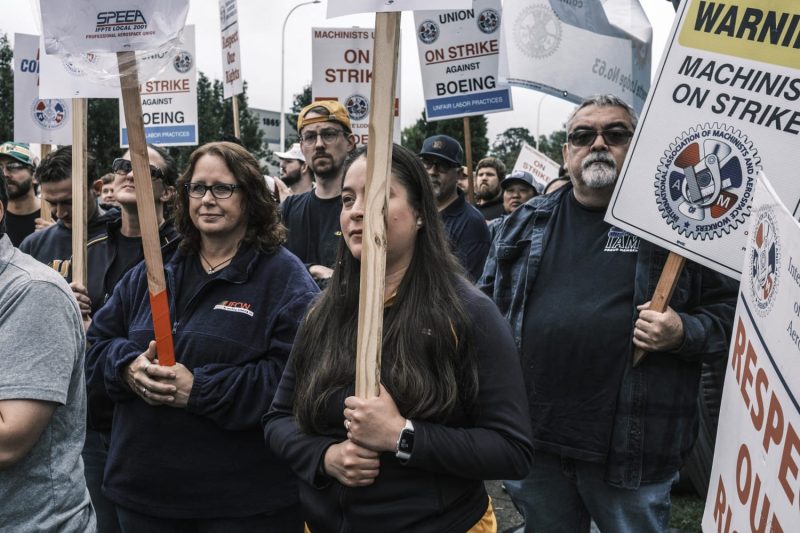RENTON, Wash. — Cash-strapped Boeing is facing mounting costs from an ongoing machinist strike as workers push for higher pay. A failure to get a deal done could be even more expensive.
In the shadow of a factory outside Seattle where Boeing makes its best-selling planes, picketing Boeing machinists told CNBC they have saved up money and have taken or are considering taking side jobs in landscaping, furniture moving or warehouse work to make ends meet if the strike is goes on much longer.
The work stoppage by Boeing’s factory workers in the Pacific Northwest just entered its second week. The financial cost of the strike on Boeing depends on how long it lasts, though ratings agencies have warned that the company could face a downgrade if it drags on too long.
That would add to the borrowing costs of the company, already $60 billion in debt. Boeing has burned through about $8 billion so far this year in the wake of a near-catastrophic door plug blowout from one of its 737 Max planes in January.
Boeing hasn’t turned an annual profit since 2018, and its new CEO Kelly Ortberg is trying to restore the company’s reputation after months of manufacturing crises that have slowed deliveries to customers, depriving it of cash.
At the local union office in Renton, machinists were preparing for what may become a lengthy strike: Union members carried in large pallets of bottled water, while someone mixed a giant tuna salad in the kitchen to make sandwiches for workers. Union vans visited demonstration sites around Renton offering transportation to bathroom breaks for workers on picket duty. Burn barrels provided heat for chilly overnight pickets.
Many workers spoke of their love for their jobs but fretted about the high cost of living in the Seattle area, where the majority of Boeing’s aircraft are made.
The median home price in Washington state increased about 142% to $613,000 as of 2023, from $253,800 a decade earlier, according to the state’s Office of Financial Management. That outpaces the roughly 55% increase nationally over that period, according to data from the Federal Reserve Bank of St. Louis.
“We can’t afford [to own] a home,” said Jake Meyer, a Boeing mechanic who said he will start driving for a food delivery service during the strike and is looking at picking up odd jobs such as moving furniture. Meyer said although he’s striking for higher pay from Boeing, he enjoys the job of building airplanes.
“I take pride in my work,” he said.
Another Boeing machinist said he has been saving for months, forgoing things such as restaurants and paying three months of mortgage payments early.
“I can last as long as it takes,” said the worker, who spoke on the condition of anonymity.
More than 30,000 Boeing machinists walked off the job at midnight Sept. 13 after turning down a tentative labor deal in a nearly 95% vote — 96% voted in favor of a strike. They received their last paychecks Thursday, and health benefits are set to end on Sept. 30. A strike fund from the union will soon give them $250 a week.
The strike is costing Boeing some $50 million a day, according to estimates by Bank of America aerospace analyst Ron Epstein. The strike halted production of most of Boeing’s aircraft, and that is rippling out to the aerospace giant’s vast network of suppliers, some of which have already been told to halt shipments. Boeing is still making 787 Dreamliners at its non-union factory in South Carolina.
The battle pits a struggling Boeing against a workforce seeking wage increases and other improvements. Boeing’s most recent offer included 25% general wage increases over a four-year deal and was endorsed by the machinists union, the International Association of Machinists and Aerospace Workers District 751.
Workers said they were looking for wage increases closer to the 40% that the union had proposed as well as annual bonuses and a restoration of pensions lost more than a decade ago.
Boeing and the union were at the negotiation table this week, but both Boeing and union negotiators have said they were disappointed with the lack of progress.
“We continue to prioritize the issues you defined in the most recent survey,” union negotiators wrote to members Wednesday, “yet we are deeply concerned that the company has not addressed your top concerns. No meaningful progress was made during today’s talks.”
Ortberg, who is just six weeks on the job, announced temporary furloughs this week of tens of thousands of Boeing staff, including managers and executives, on the heels of a hiring freeze and other cost-cutting measures announced this week.
“During mediation with the union this week, we continued our good faith efforts to engage the union’s bargaining committee in meaningful negotiations to address the feedback we’ve heard from our team,” Ortberg said in a note to staff Friday.
“While we are disappointed the discussions didn’t lead to more progress, we remain very committed to reaching an agreement as soon as possible that recognizes the hard work of our employees and ends the work stoppage in the Pacific Northwest,” Ortberg wrote.
The strike, which includes Boeing machinists in the Seattle area, Oregon and a few other locations, is just the latest in a series of labor battles in recent years that has included actors, autoworkers, port workers and airline employees, all of which have won raises after strikes or strike threats.
The Biden administration has encouraged Boeing and the union to reach a deal.
“I do believe that both parties want to get to a resolution here, and hoping to see one that makes sense for the workers and it works for a company that really needs to find its way forward on so many fronts,” Transportation Secretary Pete Buttigieg told CNBC’s “Squawk Box” on Thursday.
Boeing is facing a tight labor market. During the last strike, in 2008, which lasted less than two months, the company was in better financial shape, and there was less job competition in the area.
One Boeing supplier told CNBC that furloughing or laying off workers would cause problems for months down the road because it takes so long to train staff on such technical and detailed work.
During the pandemic, Boeing and its suppliers shed thousands of workers. They’ve since struggled to hire and train workers in time for the resurgence in air travel and aircraft demand.
“You’re in an environment where skilled, technical labor is hard to get right now, particularly in aerospace and defense,” said Bank of America’s Epstein. “So what do you do to not only retain them but attract them? If they really want a pension, maybe that gives you a competitive advantage over people who are trying to attract talent.”







































